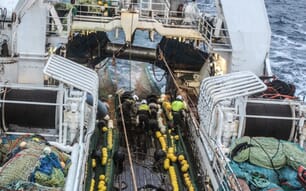Introduction
Optimal handling and storage practices at sea and ashore are essential elements in the management of fish quality and the achievement of maximum return on national and international markets.
Defining fish quality, however, is not easy. The process includes the understanding and assessment of a range of factors, many of which depend on market preferences such as: species, size, capture method, seasonal condition and freshness.
Freshness, describes the degree of spoilage a fish has undergone since capture and is an important indicator for consumers. Very importantly, and unlike many other quality attributes, this is an area within the management of the catch, over which the fishing industry exerts significant control.
Sensory assessment remains the most popular method of assessing freshness. This type of assessment uses smell, texture and visual appearance to determine the quality of fish. It is a particularly useful technique as it is low cost and requires nothing other than careful and exact training. It is a widespread and reliable assessment method and provides the foundation for the design and application of this guide.
Cod, haddock and whiting are grouped together, in this guide, as they are similar in shape, generally caught together and have similar handling requirements.
Gadus morhua
| Cod | – English |
| Cadóg | – Irish |
Bacalao |
– Spanish |
Cabillaud |
– French |
| Bacalhau | – Portuguese |
| Plamiak, ?upacz | – Polish |
Haddock has a short, rounded nose, big eyes and the first dorsal fin is pointed in shape. The body is usually a purplish grey to silvery grey colour, with the underside being white. The species can be easily distinguished from other whitefish by its black lateral line and large spot on each side of the body over the pectoral fins.
.jpg)
Melanogrammus aeglefinus
| Haddock | – English |
| Trosc | – Irish |
Eglefino |
– Spanish |
Eglefin |
– French |
| Arinca | – Portuguese |
| Dorsz | – Polish |
The Atlantic cod has one chin barbel, three dorsal fins, two anal fins and a pronounced lateral line from the gills to the tail. The dorsal area of the fish may be a rich brown to green colour, that fades to silver towards the ventral side. Some cod may have brown/red spots on the sides and back.
.jpg)
Merlangius merlangus
| Whiting | – English |
| Faoitín | – Irish |
| Merlán | – Spanish |
| Merlan | – French |
| Badejo | – Portuguese |
| Witlinek | – Polish |
The Atlantic cod has one chin barbel, three dorsal fins, two anal fins and a pronounced lateral line from the gills to the tail. The dorsal area of the fish may be a rich brown to green colour, that fades to silver towards the ventral side. Some cod may have brown/red spots on the sides and back.
.jpg)






Hygiene & Cleaning
In addition to correct handling, a high standard of hygiene and cleaning is essential to ensure production of a safe, high quality, seafood product.
- After every haul, the deck, hopper, boxes, gutting area, knives, oilskins, aprons and all other equipment, should be washed down with seawater to remove fish blood, scales, offal, dirt and any other fouling substances.
- At the end of every trip, the deck, fish hold, hoppers, boxes, gutting area, knives, oilskins, aprons and other equipment, should be washed down using a power hose and detergent to remove fish blood, scales, offal, dirt and any other fouling substances.

- A chlorine-based bleach should be used to thoroughly clean working areas and equipment, and inhibit any bacterial growth. To show the importance of this, sample swabs were taken from a hold of a boat where no bleach was used and from a hold of a boat where bleach was used. Under laboratory conditions bacterial growth was greater on the sample swab from the deck where no bleach was used. All residual bleach should be rinsed away with clean seawater.

- Detergents and sanitizing agents should be from the approved list issued by the Sea-Fisheries Protection Authority (SFPA) and should be used to the product specifications.
By-Product Utilisation
With growing interest in health products, coupled with the need to extract the maximum value from limited seafood resources, the importance of seafood by-product utilisation is growing.
Currently by-products (liver, guts, bones) from commercial fish species are simply discarded at sea, disposed of onshore or reduced to lower value fishmeal.
Ireland has recently focussed research attention in this area, which will lead to an increased demand for raw material from our seafood industry in the future.
The following are some of the valuable byproducts that have been extracted from seafood:
- Phosphorus and calcium from fish bones has anti-inflammatory properties.
- Omega-3 oils from fish livers and skeletal frames can be cleaned and used for the production of fish oil capsules.
- Bioactive peptides isolated from fish are known to have powerful antioxidant properties, which can boost the immune system.
- Fish is a rich source of vitamins A, E, C and selenium, which can protect the body from the build-up of free radicals.
- Fish skin and bone are a valuable source of collagen and gelatine.
September 2015




